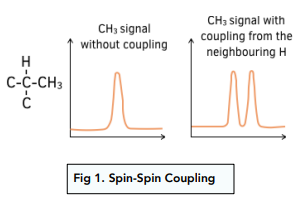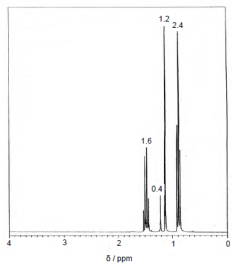Analytical Techniques - High Resolution ¹H NMR (A-Level Chemistry)
High Resolution ¹H NMR
High Resolution ¹H NMR
Using a higher resolution, you will see that the peaks in a proton NMR spectra are actually split into particular patterns. This is called spin-spin coupling.
It occurs because the magnetic field of the hydrogen atoms creating the peak are affected by all the hydrogen atoms on neighbouring C atoms.
The splitting pattern gives information about the neighbouring hydrogen atoms which can be used to work out the overall structure.
The n+1 Rule
The number of split peaks is equal to the number of hydrogen atoms on the neighbouring C atoms, plus one. It is called the n+1 rule.
- One peak – if there is one peak, not split, it is called a singlet. There are no H atoms on the neighbouring C atoms.
- Two peaks – if the peak is split into two, it is called a doublet. There is 1 H atom on the neighbouring C atoms.
- Three peaks – if the peak is split into three, it is called a triplet. There are 2 H atoms on the neighbouring C atoms.
Example: CH₃ and Coupling

The figure shows the H atoms in the CH₃ part of the molecules produce one peak in low resolution ¹H NMR.
When we look at the peak under high resolution ¹H NMR, the hydrogen atom on the adjacent C atom to the CH₃, causes the peak to split.
As there is only one hydrogen atom, the peak will split into 1+1 = two peaks as shown.
Worked Example: Explain the splitting pattern obtained on a ¹H NMR spectrum of the peak for the hydrogen atoms on the C atom labelled “a”

Answer: The splitting pattern will be a triplet.
Explanation: There are two hydrogen atoms attached to the adjacent carbon atom. So there will be three peaks.
Interpreting a High Resolution ¹H NMR Spectrum
The steps to interpreting a high resolution 1H NMR spectrum and deducing the structure of a molecule are as follows:
- Count the number of peaks. The number of peaks represents the number of hydrogen atom environments
- Use the integration ratio. If given, use the integration ratio to work out the simplest whole number ratio of H atom in each respective environment.
- Look at the singlets first. Each singlet is either produced by an R-OH group (as long as the ???? shift = 0.5-5.0 ppm) or by a group with no hydrogen atoms attached on either adjacent C atom (such as RNH)
- Consider possible structures of other peaks. Determine the possible structures of the other peaks using their ???? shift values and draw the structure with the correct number of H atoms, from the integration ratios.
- Determine the number of H atoms. Determine the number of H atoms on the adjacent C atoms from the splitting pattern of each peak.
- Draw the structure from each peak. Draw the structure from each peak and the possible adjacent C atoms.
Worked example: The diagram shows a high resolution ¹H NMR spectrum for an alcohol molecule with molecular formula C₆H₁₄O.

Deduce the structure of the molecule.
Answer:

Explanation:
- There are four peaks which means there are four different hydrogen atom environments
- The integration ratio is 1.6 : 0.4 : 1.2 : 2.4. The simplest whole number ratio = 4:1:3:6
- The singlet with an integration ratio of 1 and a ???? shift value of 1.1 must be caused by the H in OH alcohol group as this is the only environment which has 1 hydrogen atom.
- The singlet, with an integration ratio of 3 must be due to a CH₃ group. This is because there are 3 H atoms producing the peak. The singlet means there are no adjacent H atoms on the C atom. The ???? shift value of 1.2 which comes from R-CH₃. This adjacent C atom could be bonded to three other alkyl groups, but no H atom.
- Triplet at ???? shift value = 0.9 suggests an R-CH₃ group, adjacent to a CH₂ group, as a triplet is produced.
- The integration ratio of 4 and 6 indicate two equivalent CH₂CH₃ groups.






Still got a question? Leave a comment
Leave a comment